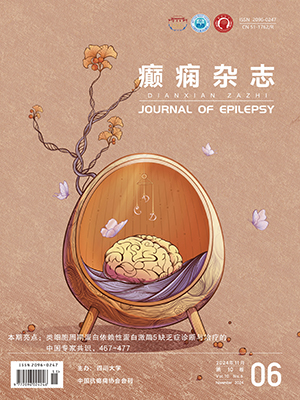| 1. |
Sanei S, Chambers JA. EEG signal processing, John Wiley & Sons Ltd, Chichester, 2007: 161.
|
| 2. |
Gandhi T, Panigrahi BK, Bhatia M, et al. Expert model for detection of epilepticactivity in EEG signature. Expert Systems with Applications, 2010, 37(4): 3513-3520.
|
| 3. |
Niedermeyer E, Lopes da Silva F. Electroencephalography: basic principles, clinical applications, and related fields, 5th Ed. Lippincott Williams & Wilkins, Philadelphia, 2005: 526.
|
| 4. |
Kjeldsen MJ, Corey LA, Christensen K, et al. Epileptic seizures and syndromes in twins: the importance of genetic factors. Epilepsy Res, 2003, 55: 137-146.
|
| 5. |
Helbig I, Scheffer IE, Mulley JC, et al. Navigating the channels and beyond: unravelling the genetics of the epilepsies. Lancet Neurol, 2008, 7: 231-245.
|
| 6. |
Dravet C, Bureau M, Oguni H, et al. Severe myoclonic epilepsy in infancy (Dravet syndrome). Epileptic Syndr Infancy Child Adolesc, 2005, 4: 89-113.
|
| 7. |
Escayg A, MacDonald BT, Meisler MH, et al. Mutations of SCN1A, encoding a neuronal sodium channel, in two families with GEFS+ 2. Nat Genet, 2000, 24: 343-345.
|
| 8. |
Shirley MD, Tang H, Gallione CJ, et al. Sturge-Weber syndrome and port-wine stains caused by somatic mutation in GNAQ. New Engl J Med, 2013, 368: 1971-1979.
|
| 9. |
Comi AM. Presentation, diagnosis, pathophysiology and treatment of the neurologic features of Sturge-Weber Syndrome. Neurol, 2011, 17: 179-184.
|
| 10. |
Archer HL, Evans J, Edwards S, et al. CDKL5 mutations cause infantile spasms, early onset seizures, and severe mental retardation in female patients. J Med. Genet, 2006, 43: 729-734.
|
| 11. |
Symonds JD, Zuberi SM, Johnson MR. Advances in epilepsy gene discovery and implications for epilepsy diagnosis and treatment. Curr Opin Neurol, 2017, 30(2): 193-199.
|
| 12. |
Johannesen K, Marini C, Pfeffer S, et al. Phenotypic spectrum of GABRA1: From generalized epilepsies to severe epileptic encephalopathies. Neurology, 2016, 87(11): 1140-1151.
|
| 13. |
Kodera H, Ohba C, Kato M, et al. De novo GABRA1 mutations in Ohtahara and West syndromes. Epilepsia, 2016, 57: 566-573.
|
| 14. |
Endele S, Rosenberger G, Geider K, et al. Mutations in GRIN2A and GRIN2B encoding regulatory subunits of NMDA receptors cause variable neurodevelopmental phenotypes. Nat Genet, 2010, 42: 1021-1026.
|
| 15. |
Carvill GL, Regan BM, Yendle SC, et al. GRIN2A mutations cause epilepsy-aphasia spectrum disorders. Nat Genet, 2013, 45: 1073-1076.
|
| 16. |
Lesca G, Rudolf G, Bruneau N, et al. GRIN2A mutations in acquired epileptic aphasia and related childhood focal epilepsies and encephalopathies with speech and language dysfunction. Nat Genet, 2013, 45: 1061-1066.
|
| 17. |
Syrbe S, Hedrich UBS, Riesch E, et al. De novo loss- or gain-of-function mutations in KCNA2 cause epileptic encephalopathy. Nat Genet, 2015, 47: 393-399.
|
| 18. |
Allou L, Julia S, Amsallem D, et al. Rett-like phenotypes: expanding the genetic heterogeneity to the KCNA2 gene and first familial case of CDKL5-related disease. Clin Genet, 2017, 91(3): 431-440.
|
| 19. |
Corbett MA, Bellows ST, Li M, et al. Dominant KCNA2 mutation causes episodic ataxia and pharmacoresponsive epilepsy. Neurology, 2016, 87(19): 1975-1984.
|
| 20. |
Ohba C, Kato M, Takahashi N, et al. De novo KCNT1 mutations in early-onset epileptic encephalopathy. Epilepsia, 2015, 56: e121-e128.
|
| 21. |
Guerrini R, Balestrini S, Wirrell EC, et al. Monogenic epilepsies: disease mechanisms, clinical phenotypes, and targeted therapies. Neurology, 2021, 97: 817-831.
|
| 22. |
Guerrini R, Dravet C, Genton P, et al. Lamotrigine and seizure aggravation in severe myoclonic epilepsy. Epilepsia, 1998, 39(5): 508-512.
|
| 23. |
Pisano T, Numis AL, Heavin SB, et al. Early and effective treatment of KCNQ2 encephalopathy. Epilepsia, 2015, 56(5): 685-691.
|
| 24. |
Symonds JD, Zuberi SM, Stewart K, et al. Incidence and phenotypes of childhood-onset genetic epilepsies: a prospective population-based national cohort. Brain, 2019, 142(8): 2303-2318.
|
| 25. |
Fruscione F, Valente P, Sterlini B, et al. PRRT2 controls neuronal excitability by negatively modulating Na+ channel 1.2/1.6 activity. Brain, 2018, 141(4): 1000-1016.
|
| 26. |
Johannesen KM, Gardella E, Linnankivi T, et al. Defining the phenotypic spectrum of SLC6A1 mutations. Epilepsia, 2018, 59(2): 389-402.
|
| 27. |
Löscher W. Single-target versus multi-target drugs versus combinations of drugs with multiple targets: preclinical and clinical evidence for the treatment or prevention of epilepsy. Front Pharmacol, 2021, 12: 730257.
|
| 28. |
Larsen J, Carvill GL, Gardella E, et al. The phenotypic spectrum of SCN8A encephalopathy. Neurology, 2015, 84: 480-489.
|
| 29. |
Rían W Manville, Geoffrey W. Abbott. Cilantro leaf harbors a potent potassium channel-activating anticonvulsant. FASEB J, 2019, 33(10): 11349-11363.
|
| 30. |
Devinsky O, Cross JH, Laux FL, et al. Trial of cannabidiol for drug-resistant seizures in the Dravet syndrome. N Engl J Med, 2017, 376: 2011-2020.
|
| 31. |
Devinsky O, Patel AD, Cross JH, et al. Effect of cannabidiol on drop seizures in the Lennox-Gastaut syndrome. N Engl J Med, 2018, 378(20): 1888-1897.
|
| 32. |
Vanoye CG, Gurnett CA, Holland KD, et al. Novel SCN3A variants associated with focal epilepsy in children. Neurobiol Dis, 2014, 62: 313-322.
|
| 33. |
Smith RS, Kenny CJ, Ganesh V, et al. Sodium channel SCN3A (NaV1. 3) regulation of human cerebral cortical folding and oral motor development. Neuron, 2018, 99(5): 905-913.
|
| 34. |
Wang SY, Wang GK. Voltage-gated sodium channels as primary targets of diverse lipid-soluble neurotoxins. Cell Signal, 2003, 15(2): 151-159.
|
| 35. |
Li X, Xu F, Xu H, et al. Structural basis for modulation of human NaV1. 3 by clinical drug and selective antagonist. Nat Commun, 2022, 13(1): 1286-1295.
|




